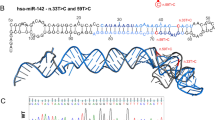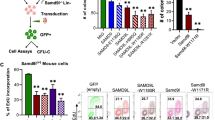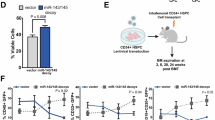Abstract
5q– syndrome is a subtype of myelodysplastic syndrome characterized by severe anemia and variable neutropenia but normal or high platelet counts with dysplastic megakaryocytes. We examined expression of microRNAs (miRNAs) encoded on chromosome 5q as a possible cause of haploinsufficiency. We show that deletion of chromosome 5q correlates with loss of two miRNAs that are abundant in hematopoietic stem/progenitor cells (HSPCs), miR-145 and miR-146a, and we identify Toll–interleukin-1 receptor domain–containing adaptor protein (TIRAP) and tumor necrosis factor receptor–associated factor-6 (TRAF6) as respective targets of these miRNAs. TIRAP is known to lie upstream of TRAF6 in innate immune signaling. Knockdown of miR-145 and miR-146a together or enforced expression of TRAF6 in mouse HSPCs resulted in thrombocytosis, mild neutropenia and megakaryocytic dysplasia. A subset of mice transplanted with TRAF6-expressing marrow progressed either to marrow failure or acute myeloid leukemia. Thus, inappropriate activation of innate immune signals in HSPCs phenocopies several clinical features of 5q– syndrome.
This is a preview of subscription content, access via your institution
Access options
Subscribe to this journal
Receive 12 print issues and online access
$209.00 per year
only $17.42 per issue
Buy this article
- Purchase on SpringerLink
- Instant access to full article PDF
Prices may be subject to local taxes which are calculated during checkout





Similar content being viewed by others
References
Corey, S.J. et al. Myelodysplastic syndromes: the complexity of stem-cell diseases. Nat. Rev. Cancer 7, 118–129 (2007).
Nilsson, L. et al. Isolation and characterization of hematopoietic progenitor/stem cells in 5q–deleted myelodysplastic syndromes: evidence for involvement at the hematopoietic stem cell level. Blood 96, 2012–2021 (2000).
Nilsson, L. et al. The molecular signature of MDS stem cells supports a stem-cell origin of 5q myelodysplastic syndromes. Blood 110, 3005–3014 (2007).
Thanopoulou, E. et al. Engraftment of NOD/SCID-β2 microglobulin null mice with multilineage neoplastic cells from patients with myelodysplastic syndrome. Blood 103, 4285–4293 (2004).
Nimer, S.D. Myelodysplastic syndromes. Blood 111, 4841–4851 (2008).
Li, X., Bryant, C.E. & Deeg, H.J. Simultaneous demonstration of clonal chromosome abnormalities and apoptosis in individual marrow cells in myelodysplastic syndrome. Int. J. Hematol. 80, 140–145 (2004).
Giagounidis, A.A., Germing, U. & Aul, C. Biological and prognostic significance of chromosome 5q deletions in myeloid malignancies. Clin. Cancer Res. 12, 5–10 (2006).
Boultwood, J. et al. Narrowing and genomic annotation of the commonly deleted region of the 5q– syndrome. Blood 99, 4638–4641 (2002).
Martíinez-Ramirez, A. et al. Analysis of myelodysplastic syndromes with complex karyotypes by high-resolution comparative genomic hybridization and subtelomeric CGH array. Genes Chromosom. Cancer 42, 287–298 (2005).
Wang, L. et al. Genome-wide analysis of copy number changes and loss of heterozygosity in myelodysplastic syndrome with del(5q) using high-density single nucleotide polymorphism arrays. Haematologica 93, 994–1000 (2008).
Ebert, B.L. et al. Identification of RPS14 as a 5q– syndrome gene by RNA interference screen. Nature 451, 335–339 (2008).
Bartel, D.P. MicroRNAs: genomics, biogenesis, mechanism and function. Cell 116, 281–297 (2004).
Ebert, M.S., Neilson, J.R. & Sharp, P.A. MicroRNA sponges: competitive inhibitors of small RNAs in mammalian cells. Nat. Methods 4, 721–726 (2007).
Gentner, B. et al. Stable knockdown of microRNA in vivo by lentiviral vectors. Nat. Methods 6, 63–66 (2009).
Bigoni, R. et al. Multilineage involvement in the 5q– syndrome: a fluorescent in situ hybridization study on bone marrow smears. Haematologica 86, 375–381 (2001).
Kroef, M.J. et al. Mosaicism of the 5q deletion as assessed by interphase FISH is a common phenomenon in MDS and restricted to myeloid cells. Leukemia 11, 519–523 (1997).
Lewis, B.P., Shih, I.H., Jones-Rhoades, M.W., Bartel, D.P. & Burge, C.B. Prediction of mammalian microRNA targets. Cell 115, 787–798 (2003).
Taganov, K.D., Boldin, M.P., Chang, K.J. & Baltimore, D. NF-κB–dependent induction of microRNA miR-146, an inhibitor targeted to signaling proteins of innate immune responses. Proc. Natl. Acad. Sci. USA 103, 12481–12486 (2006).
Lamothe, B. et al. Site-specific Lys-63-linked tumor necrosis factor receptor–associated factor 6 auto-ubiquitination is a critical determinant of I κ B kinase activation. J. Biol. Chem. 282, 4102–4112 (2007).
Mansell, A., Brint, E., Gould, J.A., O'Neill, L.A. & Hertzog, P.J. Mal interacts with tumor necrosis factor receptor-associated factor (TRAF)-6 to mediate NF-κB activation by Toll-like receptor (TLR)-2 and TLR4. J. Biol. Chem. 279, 37227–37230 (2004).
Wang, C. et al. TAK1 is a ubiquitin-dependent kinase of MKK and IKK. Nature 412, 346–351 (2001).
Nimer, S.D. Clinical management of myelodysplastic syndromes with interstitial deletion of chromosome 5q. J. Clin. Oncol. 24, 2576–2582 (2006).
Kishimoto, T. Interleukin-6: from basic science to medicine—40 years in immunology. Annu. Rev. Immunol. 23, 1–21 (2005).
Garzon, R. et al. MicroRNA signatures associated with cytogenetics and prognosis in acute myeloid leukemia. Blood 111, 3183–3189 (2008).
Marcucci, G. et al. MicroRNA expression in cytogenetically normal acute myeloid leukemia. N. Engl. J. Med. 358, 1919–1928 (2008).
Takada, S. et al. MicroRNA expression profiles of human leukemias. Leukemia 22, 1274–1278 (2008).
Rakoff-Nahoum, S. & Medzhitov, R. Regulation of spontaneous intestinal tumorigenesis through the adaptor protein MyD88. Science 317, 124–127 (2007).
Bhaumik, D. et al. Expression of microRNA-146 suppresses NF-κB activity with reduction of metastatic potential in breast cancer cells. Oncogene 27, 5643–5647 (2008).
Chen, H. et al. Interference with nuclear factor κ B and c-Jun NH2-terminal kinase signaling by TRAF6C small interfering RNA inhibits myeloma cell proliferation and enhances apoptosis. Oncogene 25, 6520–6527 (2006).
Maratheftis, C.I., Andreakos, E., Moutsopoulos, H.M. & Voulgarelis, M. Toll-like receptor-4 is up-regulated in hematopoietic progenitor cells and contributes to increased apoptosis in myelodysplastic syndromes. Clin. Cancer Res. 13, 1154–1160 (2007).
Hofmann, W.K. et al. Characterization of gene expression of CD34+ cells from normal and myelodysplastic bone marrow. Blood 100, 3553–3560 (2002).
Gondek, L.P. et al. Chromosomal lesions and uniparental disomy detected by SNP arrays in MDS, MDS/MPD and MDS-derived AML. Blood 111, 1534–1542 (2008).
Starczynowski, D.T. et al. High-resolution whole genome tiling path array CGH analysis of CD34+ cells from patients with low-risk myelodysplastic syndromes reveals cryptic copy number alterations and predicts overall and leukemia-free survival. Blood 112, 3412–3424 (2008).
Garzon, R. et al. Distinctive microRNA signature of acute myeloid leukemia bearing cytoplasmic mutated nucleophosmin. Proc. Natl. Acad. Sci. USA 105, 3945–3950 (2008).
Garzon, R. et al. MicroRNA signatures associated with cytogenetics and prognosis in acute myeloid leukemia. Blood 111, 3183–3189 (2008).
Jongen-Lavrencic, M., Sun, S.M., Dijkstra, M.K., Valk, P.J. & Lowenberg, B. MicroRNA expression profiling in relation to the genetic heterogeneity of acute myeloid leukemia. Blood 111, 5078–5085 (2008).
Li, Z. et al. Distinct microRNA expression profiles in acute myeloid leukemia with common translocations. Proc. Natl. Acad. Sci. USA 105, 15535–15540 (2008).
Takada, S. et al. MicroRNA expression profiles of human leukemias. Leukemia 22, 1274–1278 (2008).
Hast, R., Eriksson, M., Widell, S., Arvidsson, I. & Bemell, P. Neutrophil dysplasia is not a specific feature of the abnormal chromosomal clone in myelodysplastic syndromes. Leuk. Res. 23, 579–584 (1999).
Herold, M., Schmalzl, F. & Zwierzina, H. Increased serum interleukin 6 levels in patients with myelodysplastic syndromes. Leuk. Res. 16, 585–588 (1992).
Verhoef, G.E. et al. Measurement of serum cytokine levels in patients with myelodysplastic syndromes. Leukemia 6, 1268–1272 (1992).
Hsu, H.C. et al. Circulating levels of thrombopoietic and inflammatory cytokines in patients with acute myeloblastic leukemia and myelodysplastic syndrome. Oncology 63, 64–69 (2002).
Brandt, S.J., Bodine, D.M., Dunbar, C.E. & Nienhuis, A.W. Dysregulated interleukin 6 expression produces a syndrome resembling Castleman's disease in mice. J. Clin. Invest. 86, 592–599 (1990).
Hawley, R.G., Fong, A.Z., Burns, B.F. & Hawley, T.S. Transplantable myeloproliferative disease induced in mice by an interleukin 6 retrovirus. J. Exp. Med. 176, 1149–1163 (1992).
Corral, L.G. et al. Differential cytokine modulation and T cell activation by two distinct classes of thalidomide analogues that are potent inhibitors of TNF-α. J. Immunol. 163, 380–386 (1999).
Nagai, Y. et al. Toll-like receptors on hematopoietic progenitor cells stimulate innate immune system replenishment. Immunity 24, 801–812 (2006).
Tang, M. et al. TAK1 is required for the survival of hematopoietic cells and hepatocytes in mice. J. Exp. Med. 205, 1611–1619 (2008).
Antonchuk, J., Sauvageau, G. & Humphries, R.K. HOXB4-induced expansion of adult hematopoietic stem cells ex vivo. Exp. Hematol. 29, 1125–1134 (2001).
Larrivée, B., Pollet, I. & Karsan, A. Activation of vascular endothelial growth factor receptor-2 in bone marrow leads to accumulation of myeloid cells: role of granulocyte-macrophage colony-stimulating factor. J. Immunol. 175, 3015–3024 (2005).
Acknowledgements
We thank R. Deleeuw, R. Chari, W. Lockwood, S. Watson and E. Vucic for technical assistance and helpful discussions and M. Abbott for animal husbandry. K. Tohyama (Kawasaki Medical School) provided the MDS-L cell line. The NF-κB site–containing luciferase reporter plasmid was a gift from F. Jirik (University of Calgary). This work was supported by the Canadian Institutes of Health Research (CIHR; MOP 89976), Leukemia and Lymphoma Society of Canada and Canadian Cancer Society grants to A.K., a CIHR grant and a Terry Fox Foundation Program Project award to R.K.H., and a Stem Cell Network grant to M.M. D.T.S. is supported in part by CIHR and Michael Smith Foundation for Health Research (MSFHR) fellowships. M.M. and A.K. are Senior Scholars of the MSFHR.
Author information
Authors and Affiliations
Contributions
D.T.S. and A.K. participated in designing the research and drafting the manuscript; D.T.S. and S.S. performed experiments; F.K., B.A., A.M., and R.M. provided technical assistance and discussion; R.A.W. and R.B. provided human subject samples; D.H. and R.K.H. provided valuable advice and expertise; M.H. and M.M. provided reagents and expertise in small RNA sequencing; W.L. provided valuable reagents and expertise in array comparative genomic hybridization.
Corresponding author
Supplementary information
Supplementary Text and Figures
Supplementary Figures 1–12, Supplementary Tables 1–9 and Supplementary Methods (PDF 7476 kb)
Rights and permissions
About this article
Cite this article
Starczynowski, D., Kuchenbauer, F., Argiropoulos, B. et al. Identification of miR-145 and miR-146a as mediators of the 5q– syndrome phenotype. Nat Med 16, 49–58 (2010). https://doi.org/10.1038/nm.2054
Received:
Accepted:
Published:
Issue Date:
DOI: https://doi.org/10.1038/nm.2054
This article is cited by
-
Role of innate immunological/inflammatory pathways in myelodysplastic syndromes and AML: a narrative review
Experimental Hematology & Oncology (2023)
-
Insight into microRNAs’ involvement in hematopoiesis: current standing point of findings
Stem Cell Research & Therapy (2023)
-
The value of serum IL-4 to predict the survival of MDS patients
European Journal of Medical Research (2023)
-
Control of focal adhesion kinase activation by RUNX1-regulated miRNAs in high-risk AML
Leukemia (2023)
-
Epigenetic regulation in hematopoiesis and its implications in the targeted therapy of hematologic malignancies
Signal Transduction and Targeted Therapy (2023)



